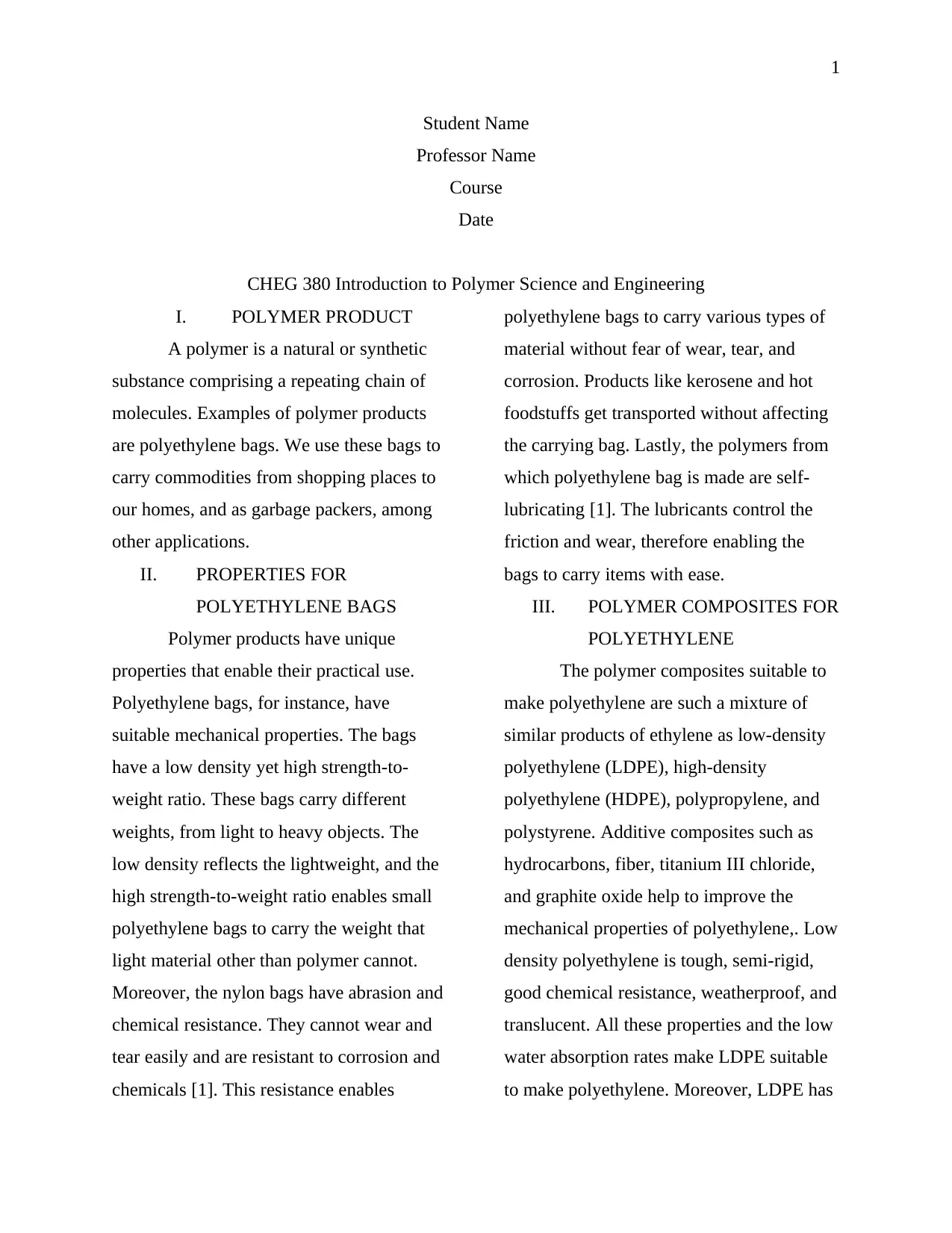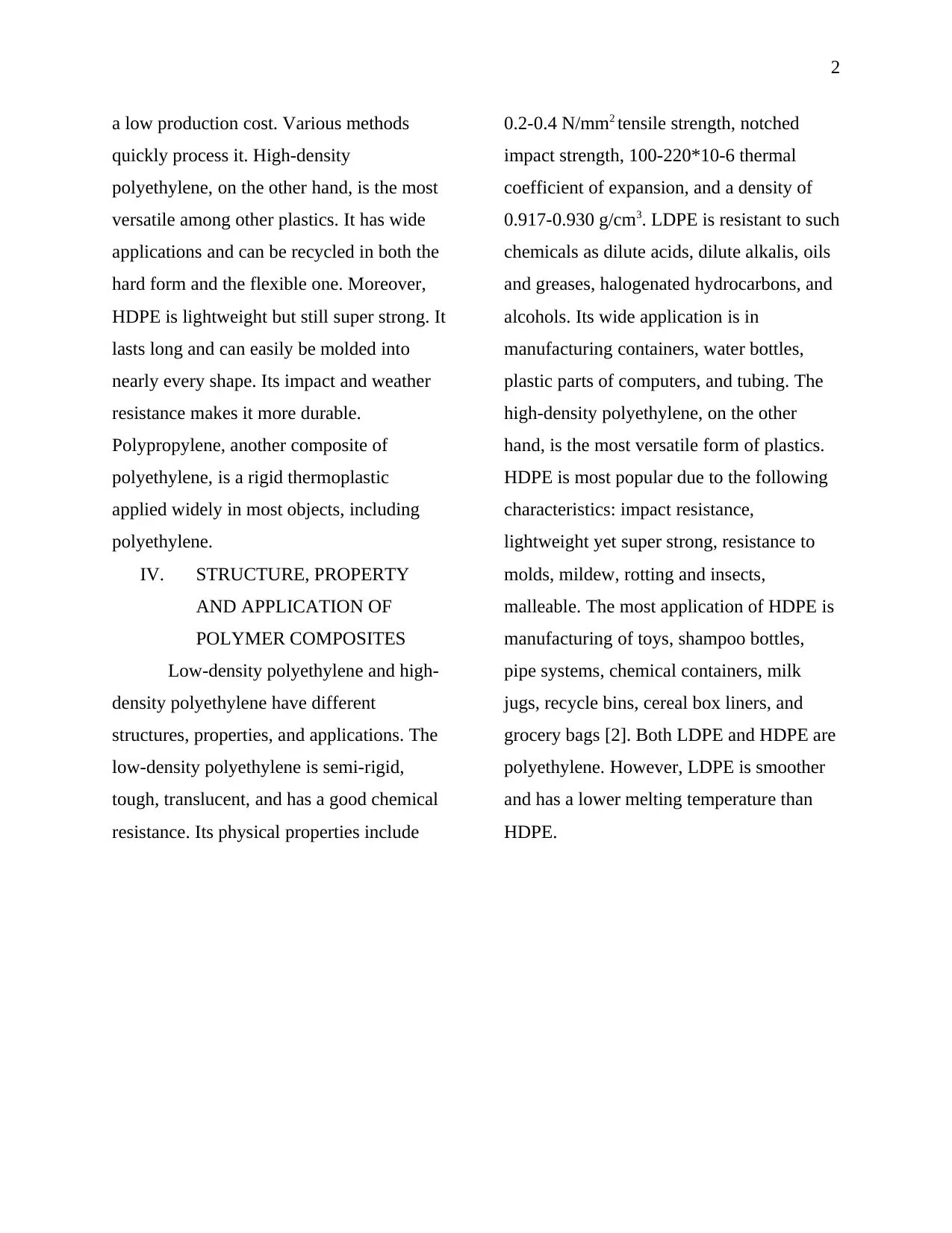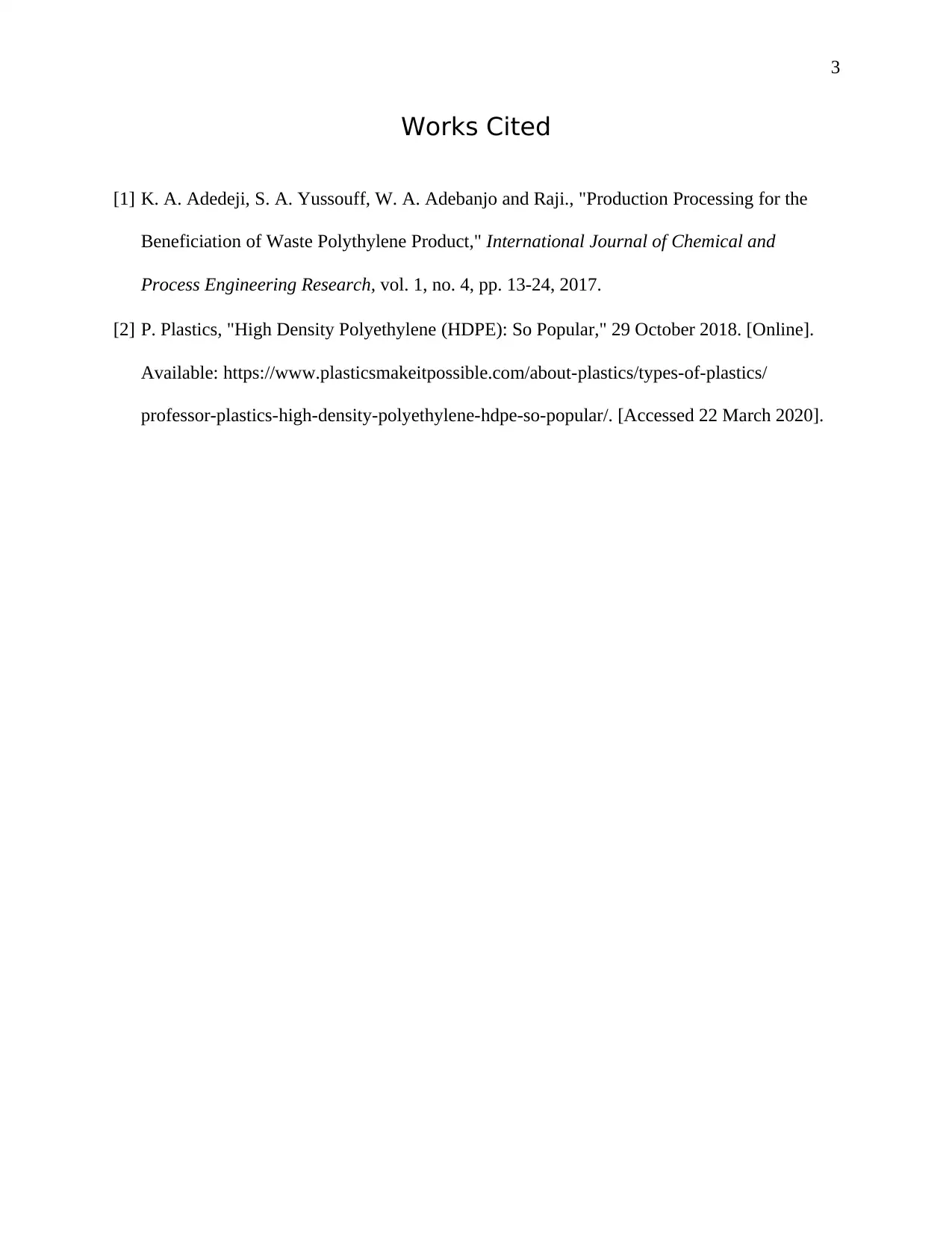Polymer Product Properties and Composites - CHEG 380 Assignment
VerifiedAdded on 2022/08/27
|3
|743
|19
Homework Assignment
AI Summary
This assignment analyzes polyethylene bags as a polymer product, detailing their key properties such as low density, high strength-to-weight ratio, abrasion resistance, and chemical resistance, making them suitable for carrying various materials. The solution identifies polymer composites like LDPE, HDPE, polypropylene, and polystyrene as suitable materials, justifying their selection based on their characteristics. It further elaborates on the structure, properties, and applications of LDPE and HDPE, highlighting their differences in terms of tensile strength, chemical resistance, and applications in manufacturing containers, bottles, and various other products. The assignment concludes with cited references to support the analysis.

1
Student Name
Professor Name
Course
Date
CHEG 380 Introduction to Polymer Science and Engineering
I. POLYMER PRODUCT
A polymer is a natural or synthetic
substance comprising a repeating chain of
molecules. Examples of polymer products
are polyethylene bags. We use these bags to
carry commodities from shopping places to
our homes, and as garbage packers, among
other applications.
II. PROPERTIES FOR
POLYETHYLENE BAGS
Polymer products have unique
properties that enable their practical use.
Polyethylene bags, for instance, have
suitable mechanical properties. The bags
have a low density yet high strength-to-
weight ratio. These bags carry different
weights, from light to heavy objects. The
low density reflects the lightweight, and the
high strength-to-weight ratio enables small
polyethylene bags to carry the weight that
light material other than polymer cannot.
Moreover, the nylon bags have abrasion and
chemical resistance. They cannot wear and
tear easily and are resistant to corrosion and
chemicals [1]. This resistance enables
polyethylene bags to carry various types of
material without fear of wear, tear, and
corrosion. Products like kerosene and hot
foodstuffs get transported without affecting
the carrying bag. Lastly, the polymers from
which polyethylene bag is made are self-
lubricating [1]. The lubricants control the
friction and wear, therefore enabling the
bags to carry items with ease.
III. POLYMER COMPOSITES FOR
POLYETHYLENE
The polymer composites suitable to
make polyethylene are such a mixture of
similar products of ethylene as low-density
polyethylene (LDPE), high-density
polyethylene (HDPE), polypropylene, and
polystyrene. Additive composites such as
hydrocarbons, fiber, titanium III chloride,
and graphite oxide help to improve the
mechanical properties of polyethylene,. Low
density polyethylene is tough, semi-rigid,
good chemical resistance, weatherproof, and
translucent. All these properties and the low
water absorption rates make LDPE suitable
to make polyethylene. Moreover, LDPE has
Student Name
Professor Name
Course
Date
CHEG 380 Introduction to Polymer Science and Engineering
I. POLYMER PRODUCT
A polymer is a natural or synthetic
substance comprising a repeating chain of
molecules. Examples of polymer products
are polyethylene bags. We use these bags to
carry commodities from shopping places to
our homes, and as garbage packers, among
other applications.
II. PROPERTIES FOR
POLYETHYLENE BAGS
Polymer products have unique
properties that enable their practical use.
Polyethylene bags, for instance, have
suitable mechanical properties. The bags
have a low density yet high strength-to-
weight ratio. These bags carry different
weights, from light to heavy objects. The
low density reflects the lightweight, and the
high strength-to-weight ratio enables small
polyethylene bags to carry the weight that
light material other than polymer cannot.
Moreover, the nylon bags have abrasion and
chemical resistance. They cannot wear and
tear easily and are resistant to corrosion and
chemicals [1]. This resistance enables
polyethylene bags to carry various types of
material without fear of wear, tear, and
corrosion. Products like kerosene and hot
foodstuffs get transported without affecting
the carrying bag. Lastly, the polymers from
which polyethylene bag is made are self-
lubricating [1]. The lubricants control the
friction and wear, therefore enabling the
bags to carry items with ease.
III. POLYMER COMPOSITES FOR
POLYETHYLENE
The polymer composites suitable to
make polyethylene are such a mixture of
similar products of ethylene as low-density
polyethylene (LDPE), high-density
polyethylene (HDPE), polypropylene, and
polystyrene. Additive composites such as
hydrocarbons, fiber, titanium III chloride,
and graphite oxide help to improve the
mechanical properties of polyethylene,. Low
density polyethylene is tough, semi-rigid,
good chemical resistance, weatherproof, and
translucent. All these properties and the low
water absorption rates make LDPE suitable
to make polyethylene. Moreover, LDPE has
Paraphrase This Document
Need a fresh take? Get an instant paraphrase of this document with our AI Paraphraser

2
a low production cost. Various methods
quickly process it. High-density
polyethylene, on the other hand, is the most
versatile among other plastics. It has wide
applications and can be recycled in both the
hard form and the flexible one. Moreover,
HDPE is lightweight but still super strong. It
lasts long and can easily be molded into
nearly every shape. Its impact and weather
resistance makes it more durable.
Polypropylene, another composite of
polyethylene, is a rigid thermoplastic
applied widely in most objects, including
polyethylene.
IV. STRUCTURE, PROPERTY
AND APPLICATION OF
POLYMER COMPOSITES
Low-density polyethylene and high-
density polyethylene have different
structures, properties, and applications. The
low-density polyethylene is semi-rigid,
tough, translucent, and has a good chemical
resistance. Its physical properties include
0.2-0.4 N/mm2 tensile strength, notched
impact strength, 100-220*10-6 thermal
coefficient of expansion, and a density of
0.917-0.930 g/cm3. LDPE is resistant to such
chemicals as dilute acids, dilute alkalis, oils
and greases, halogenated hydrocarbons, and
alcohols. Its wide application is in
manufacturing containers, water bottles,
plastic parts of computers, and tubing. The
high-density polyethylene, on the other
hand, is the most versatile form of plastics.
HDPE is most popular due to the following
characteristics: impact resistance,
lightweight yet super strong, resistance to
molds, mildew, rotting and insects,
malleable. The most application of HDPE is
manufacturing of toys, shampoo bottles,
pipe systems, chemical containers, milk
jugs, recycle bins, cereal box liners, and
grocery bags [2]. Both LDPE and HDPE are
polyethylene. However, LDPE is smoother
and has a lower melting temperature than
HDPE.
a low production cost. Various methods
quickly process it. High-density
polyethylene, on the other hand, is the most
versatile among other plastics. It has wide
applications and can be recycled in both the
hard form and the flexible one. Moreover,
HDPE is lightweight but still super strong. It
lasts long and can easily be molded into
nearly every shape. Its impact and weather
resistance makes it more durable.
Polypropylene, another composite of
polyethylene, is a rigid thermoplastic
applied widely in most objects, including
polyethylene.
IV. STRUCTURE, PROPERTY
AND APPLICATION OF
POLYMER COMPOSITES
Low-density polyethylene and high-
density polyethylene have different
structures, properties, and applications. The
low-density polyethylene is semi-rigid,
tough, translucent, and has a good chemical
resistance. Its physical properties include
0.2-0.4 N/mm2 tensile strength, notched
impact strength, 100-220*10-6 thermal
coefficient of expansion, and a density of
0.917-0.930 g/cm3. LDPE is resistant to such
chemicals as dilute acids, dilute alkalis, oils
and greases, halogenated hydrocarbons, and
alcohols. Its wide application is in
manufacturing containers, water bottles,
plastic parts of computers, and tubing. The
high-density polyethylene, on the other
hand, is the most versatile form of plastics.
HDPE is most popular due to the following
characteristics: impact resistance,
lightweight yet super strong, resistance to
molds, mildew, rotting and insects,
malleable. The most application of HDPE is
manufacturing of toys, shampoo bottles,
pipe systems, chemical containers, milk
jugs, recycle bins, cereal box liners, and
grocery bags [2]. Both LDPE and HDPE are
polyethylene. However, LDPE is smoother
and has a lower melting temperature than
HDPE.

3
Works Cited
[1] K. A. Adedeji, S. A. Yussouff, W. A. Adebanjo and Raji., "Production Processing for the
Beneficiation of Waste Polythylene Product," International Journal of Chemical and
Process Engineering Research, vol. 1, no. 4, pp. 13-24, 2017.
[2] P. Plastics, "High Density Polyethylene (HDPE): So Popular," 29 October 2018. [Online].
Available: https://www.plasticsmakeitpossible.com/about-plastics/types-of-plastics/
professor-plastics-high-density-polyethylene-hdpe-so-popular/. [Accessed 22 March 2020].
Works Cited
[1] K. A. Adedeji, S. A. Yussouff, W. A. Adebanjo and Raji., "Production Processing for the
Beneficiation of Waste Polythylene Product," International Journal of Chemical and
Process Engineering Research, vol. 1, no. 4, pp. 13-24, 2017.
[2] P. Plastics, "High Density Polyethylene (HDPE): So Popular," 29 October 2018. [Online].
Available: https://www.plasticsmakeitpossible.com/about-plastics/types-of-plastics/
professor-plastics-high-density-polyethylene-hdpe-so-popular/. [Accessed 22 March 2020].
⊘ This is a preview!⊘
Do you want full access?
Subscribe today to unlock all pages.

Trusted by 1+ million students worldwide
1 out of 3
Related Documents
Your All-in-One AI-Powered Toolkit for Academic Success.
+13062052269
info@desklib.com
Available 24*7 on WhatsApp / Email
![[object Object]](/_next/static/media/star-bottom.7253800d.svg)
Unlock your academic potential
Copyright © 2020–2025 A2Z Services. All Rights Reserved. Developed and managed by ZUCOL.





